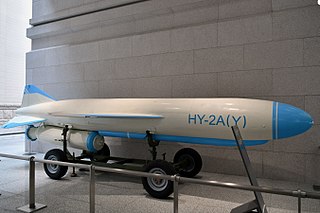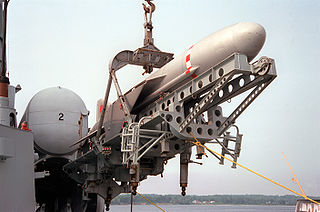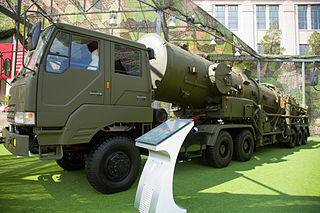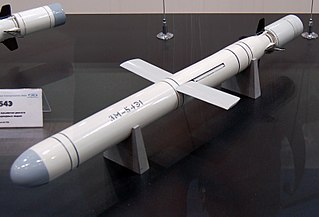Related Research Articles

A cruise missile is a guided missile used against terrestrial targets, that remains in the atmosphere and flies the major portion of its flight path at approximately constant speed. Cruise missiles are designed to deliver a large warhead over long distances with high precision. Modern cruise missiles are capable of travelling at supersonic or high subsonic speeds, are self-navigating, and are able to fly on a non-ballistic, extremely low-altitude trajectory.

A ramjet, sometimes referred to as a flying stovepipe or an athodyd, is a form of airbreathing jet engine that uses the engine's forward motion to compress incoming air without an axial compressor or a centrifugal compressor. Because ramjets cannot produce thrust at zero airspeed, they cannot move an aircraft from a standstill. A ramjet-powered vehicle, therefore, requires an assisted take-off like a rocket assist to accelerate it to a speed where it begins to produce thrust. Ramjets work most efficiently at supersonic speeds around Mach 3. This type of engine can operate up to speeds of Mach 6.

The Shang You or SY-series, and the Hai Ying or HY-series were early Chinese anti-ship cruise missiles. They were derived from the Soviet P-15 Termit missile.

A scramjet is a variant of a ramjet airbreathing jet engine in which combustion takes place in supersonic airflow. As in ramjets, a scramjet relies on high vehicle speed to compress the incoming air forcefully before combustion, but whereas a ramjet decelerates the air to subsonic velocities before combustion, the airflow in a scramjet is supersonic throughout the entire engine. This allows the scramjet to operate efficiently at extremely high speeds.

The P-15 Termit is an anti-ship missile developed by the Soviet Union's Raduga design bureau in the 1950s. Its GRAU designation was 4K40, its NATO reporting name was Styx or SS-N-2. China acquired the design in 1958 and created at least four versions: the CSS-N-1 Scrubbrush and CSS-N-2 versions were developed for ship-launched operation, while the CSS-C-2 Silkworm and CSS-C-3 Seersucker were used for coastal defence. Other names for this basic type of missile include: HY-1, SY-1, and FL-1 Flying Dragon. North Korean local produced KN-1 or KN-01, derived from both Silkworm variants and Russian & USSR P-15, Rubezh, P-20 P-22.

Seaslug was a first-generation surface-to-air missile designed by Armstrong Whitworth for use by the Royal Navy. Tracing its history as far back as 1943's LOPGAP design, it came into operational service in 1961 and was still in use at the time of the Falklands War in 1982.
The BAe Sea Eagle is a medium weight sea-skimming anti-ship missile designed and built by BAe Dynamics. It is designed to sink or disable ships up to the size of aircraft carriers in the face of jamming and other countermeasures including decoys. Its users include the Royal Air Force and Royal Navy, the Royal Saudi Air Force, and the Indian Navy.

The North American SM-64 Navaho was a supersonic intercontinental cruise missile project built by North American Aviation (NAA). The final design was capable of delivering a nuclear weapon to the USSR from bases in the US, while cruising at Mach 3 at 60,000 feet (18,000 m) altitude. The missile is named after the Navajo Nation.

The Hsiung Feng III is a medium range supersonic missile with capabilities to destroy both land based targets and naval targets developed by the National Chung-Shan Institute of Science and Technology (NCSIST) in Taiwan.
The Hsiung Feng IIE is a surface-to-surface cruise missile system developed by the National Chung-Shan Institute of Science and Technology (NCSIST) in Taiwan.
The TL-6 or Sky Dragon - 6 is a light anti-ship missile.
The TL-10 or Sky Dragon (天龙) - 10 is a light anti-ship missile unveiled in the Zhuhai Airshow in 2004 in China, and it is the Chinese equivalent of the French MM-15TT / AS-15TT light anti-ship missile developed by Aérospatiale.
The C-101 is a Chinese supersonic anti-ship cruise missile. It is manufactured by the China Aerospace Science and Industry Corporation Third Academy.

The C-301 is a large supersonic coastal defense anti-ship missile (AShM), and it is the basis on which two other members of the C-300 series AShM C-302 and C-303 developed from.

The Dong-Feng 21 (DF-21; NATO reporting name CSS-5 - Dong-Feng is a two-stage, solid-fuel rocket, single-warhead medium-range ballistic missile in the Dong Feng series developed by China Changfeng Mechanics and Electronics Technology Academy. Development started in the late 1960s and was completed around 1985–86, but it was not deployed until 1991. It was developed from the submarine-launched JL-1 missile, and is China's first solid-fuel land-based missile. The U.S. Department of Defense in 2008 estimated that China had 60-80 missiles and 60 launchers; approximately 10-11 missiles can be built annually.

The 3M-54 Kalibr,, also referred to it as 3M54-1 Kalibr, 3M14 Biryuza, , 91R1, 91RT2 is a group of Russian surface ship-, submarine-launched and airborne anti-ship and coastal anti ship (AShM), land attack cruise missiles (LACM) and anti-submarine missiles developed by the Novator Design Bureau (OKB-8). Derived export versions are the 3M54E, 3M54E1, 3M14E, 91RE1, 91RTE2. The 3M54T, 3M54K, 3M54A, 3M54E (3M54TE), 3M54KE and 3M54AE have a second stage that performs a supersonic sprint in the terminal approach to the target, reducing the time that target's defense systems have to react. The 3M54T1, 3M54K1, 3M54A1, 3M54E1 (3M54T/K/AE1) only travel at subsonic speeds, although their range is accordingly greater than those of the supersonic versions.
The YJ-12 is a Chinese supersonic anti-ship cruise missile.
The SSM-N-2 Triton was a supersonic nuclear land-attack cruise missile project for the United States Navy. It was in development from 1946 to 1957, but probably no prototypes were produced or tested. The Triton program was approved in September 1946, designated SSM-2 a year later, and redesignated SSM-N-2 in early 1948. A preliminary design was produced by 1950 as the XSSM-N-2, but was scaled down by 1955 and redesigned again in 1957. Triton was cancelled in 1957, probably as a result of the 1956 decision to focus the Navy's strategic weapons development on the Polaris submarine-launched ballistic missile. In any case, prototypes of the similar Regulus II missile had already flown, and Triton was redundant, offering only an increase in range from 1,000 nautical miles (1,900 km) to 1,500 nautical miles (2,800 km), which Polaris was about to achieve along with many other advantages. Regulus II was itself cancelled in 1958, although testing of missiles already built continued for several years.

The YJ-18 is a Chinese family of anti-ship and land attack cruise missiles.